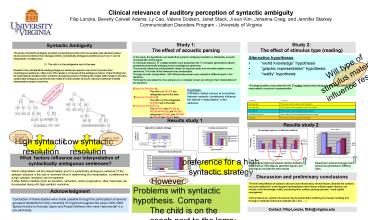Clinical relevance of auditory perception of syntactic ambiguity - PowerPoint PPT Presentation
1 / 1
Title:
Clinical relevance of auditory perception of syntactic ambiguity
Description:
Clinical relevance of auditory perception of syntactic ambiguity ... The pencil is in the cup next to the scissors. real objects ... – PowerPoint PPT presentation
Number of Views:71
Avg rating:3.0/5.0
Title: Clinical relevance of auditory perception of syntactic ambiguity
1
Clinical relevance of auditory perception of
syntactic ambiguity Filip Loncke, Beverly
Colwell Adams, Ly Cao, Valerie Dodson, Janet
Stack, Ji eun Kim, Johanna Craig, and Jennifer
Starkey Communication Disorders Program -
University of Virginia
Syntactic Ambiguity
Study 1 The effect of acoustic parsing
Study 2 The effect of stimulus type (reading)
The study of syntactic ambiguity provides a
fascinating window into how people make decisions
about structure and content as the message
unfolds. Syntactically ambiguous sentences such
as (1) can be interpreted in multiple ways.
(1) The milk is in the refrigerator next to the
beer. Research has indicated that reading
ambiguous sentences requires more time to process
than unambiguous sentences, often even if the
reader is not aware of the ambiguous nature.
These findings can be interpreted as evidence
that, somehow during the process of reading, the
reader takes longer to process syntactically
ambiguous sentences that violate an initial
simpler structure. Decisions between multiple
interpretations require more time.
In this study, the hypothesis was tested that
syntactic ambiguity resolution is affected by
acoustic characteristics of the signal. In
individual sessions, 57 college students were
presented with 72 computer generated auditorily
presented syntactically ambiguous and unambiguous
sentences. The acoustic signal was manipulated to
obtain an equal prosodic and intonation pattern
across sentences. The order of the sentences was
randomized. Through acoustic manipulation, 500
milliseconds pauses were created at different
spots in the sentence. Participants were asked to
move pictures on a computer screen according to
their interpretation of the sentence.
- Alternative hypotheses
- world knowledge hypothesis
- graphic representation hypothesis
- reality hypothesis
Will type of stimulus materials influence
results?
18 college students were presented with 20
written syntactically ambiguous sentences. The
students were asked to construct a
representation.
Pause en Position A The milk is in PAUSE the
refrigerator next to the beer. Pause en
Position B The milk is in the refrigerator PAUSE
next to the beer. Pauses en Position C The
PAUSE milk PAUSE is PAUSE in PAUSE the PAUSE
refrigerator PAUSE next PAUSE to PAUSE the PAUSE
beer.
Hypothesis Artificially created pauses at
boundaries between syntactic constituents
influence the listeners interpretation of the
sentence.
Syntactically most likely strategy
Results study 1
Results study 2
Both the milk and the beer are in the
refrigerator
The beer is outside of the refrigerator
High syntactic resolution
Low syntactic resolution
What factors influence our interpretation of
syntactically ambiguous sentences?
preference for a high syntactic strategy
Preference for high level solution remains
limited to picture stimuli. Real objects,
geometric figures, and drawings do not yield the
same results.
Response to pictures changes when pictures are
presented in differing sizes.
Which interpretation will the listener/reader
give to a syntactically ambiguous sentence? If
the syntactic structure is the sole or dominant
force in determining the interpretation, a
preference for a high syntactic resolution can be
expected. If other factors interfere (such as
acoustics, semantics, and/or pragmatics), other
responses can be expected along with high
syntactic resolution.
Discussion and preliminary conclusions
However
The final interpretation of syntactic decisions
are influenced by several factors. Besides the
syntactic structure (reflected in a tree diagram
representation) other factors influencing the
decision can include world knowledge, reality,
processing time, auditory parsing (pauses),
visual-spatial arrangement. Clinical relevance
syntactic structures may be trained both
auditorily and visually (reading) and through a
multitude of stimulus materials (SLI, ESL, )
Problems with syntactic hypothesis. Compare The
child is on the coach next to the lamp 89
low The bread is in the breadbox next to the
muffins 88 high Possible explanation Can
semantic solutions (world knowledge!) override
syntactic preferences? Also, can picture
characteristics suggest a specific solution?
Acknowledgment
Conduction of these studies were made possible
through the participation of several groups of
students from the University of Virginia
throughout the years 2005-2008. Special thanks to
Amanda Spear and Alyssa Weltman who were
instrumental in a pre-pilot study.
Contact Filip Loncke, ftl4n_at_virginia.edu































